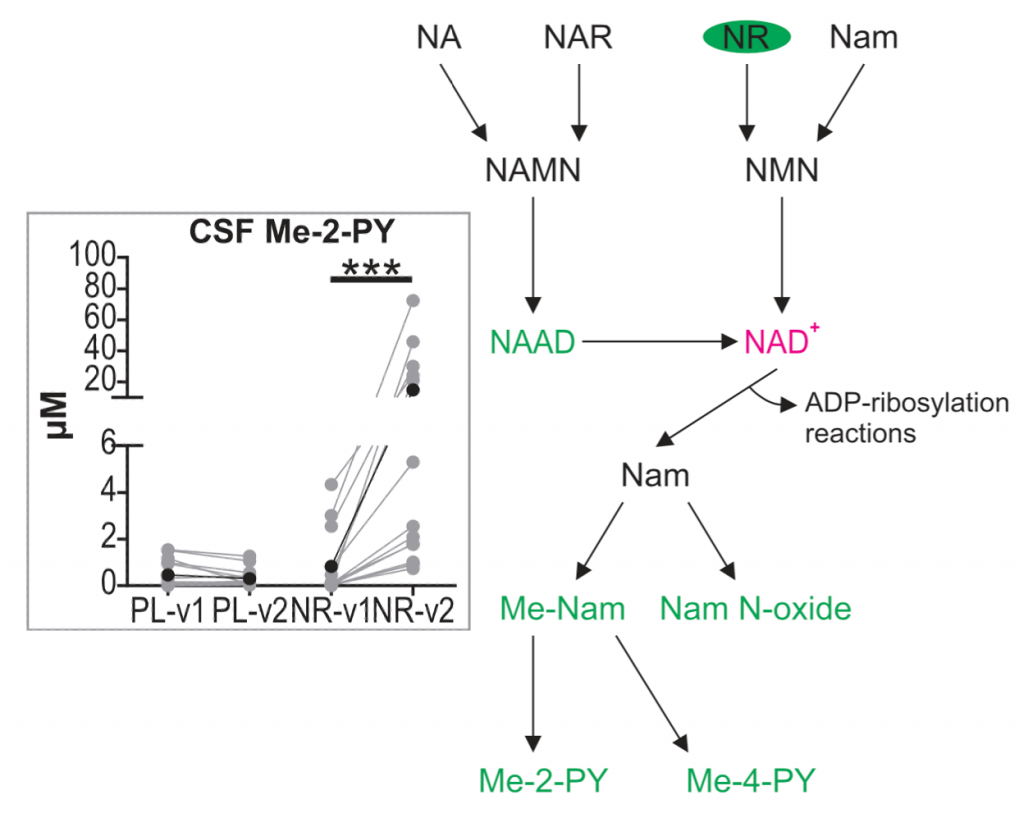Key Points:
- NR supplementation increases brain NAD+ levels and reduces brain activity in regions typically active in patients with Parkinson’s disease.
- Changes in brain patterns following NR supplementation were strongly correlated with improved physical performance.
- NR activates genes that repress Parkinson’s disease drivers: oxidative stress, mitochondrial dysfunction, and brain inflammation (neuroinflammation).
Researchers from Haukeland University in Norway published a new study in Cell Metabolism detailing a double-blind phase 1 clinical trial with nicotinamide riboside (NR), a precursor to the energy-boosting coenzyme NAD+, in patients with Parkinson’s disease. Brakedal and colleagues show that supplementing Parkinson’s patients with 1000 mg NR for 30 days successfully boosts brain NAD+ levels and reduces brain activity in regions ordinarily active in Parkinson’s patients. These NR-induced changes in brain activity had strong correlations with improved physical performance in Parkinson’s patients. When researchers analyzed how NR modulates gene activity in Parkinson’s patients, results showed that NR supplementation activates genes that block oxidative stress, mitochondrial dysfunction, and neuroinflammation. Although the clinical trial had a small subject pool and short duration, the findings are promising indicators that NR can be utilized to combat neurodegeneration.
NAD+ and Neuroprotection
NAD+ is a multifaceted life-preserving coenzyme — small molecules that help other enzymes catalyze reactions — that plays a critical role in generating cellular energy, repairing DNA, and protecting against neurological damage. Regarding NAD+’s neuroprotective effects, rodent studies have shown that boosting cellular NAD+ triggers the elimination of protein build-up that hampers cell communication in diseased brains. Also, other rodent studies have confirmed NAD+’s ability to increase cognitive function by targeting brain regions responsible for learning and memory, the hippocampus and cortex.
When NAD+ levels decline with age, cellular functions inevitably collapse, increasing our susceptibility to neurodegeneration and the progression of neurodegenerative disorders like Alzheimer’s and Parkinson’s disease. Thus, researchers have honed in on molecules capable of replenishing NAD+ levels.
NR Increases Brain NAD+ Levels in Parkinson’s Patients
In the present study, Brakedal and colleagues evaluate NR’s ability to rescue diminished NAD+ levels in Parkinson’s patients. To do so, the investigators analyzed metabolites located in the cerebrospinal fluid (CSF), a colorless fluid that surrounds the brain and spinal cord. Upon analysis, results showed that the CSF in Parkinson’s patients exhibited significantly higher levels of a compound (Me-2-PY) indicative of NR supplementation. Given that these increases were universal among all Parkinson’s-treated patients, the findings suggest that NR successfully accesses the central nervous system (CNS) and boosts brain NAD+ levels.

NR Mitigates Brain Activity Seen in Parkinson’s
When treating neurodegenerative disorders, scientists must first understand which parts of the brain are affected by the disease. So, before supplementation with NR, investigators mapped out brain images that showed which brain regions were active in Parkinson’s patients. Then, following NR supplementation and subsequent analysis of the NR-treated brain images, they found that NR reduced brain activity in regions typically active in Parkinson’s patients, indicating that the NR-related brain patterns (NRRP) overlap with many of those seen in Parkinson’s disease. Importantly, this finding indicates that NR could be utilized in future brain studies that target these overlapping brain regions.
Next, Brakedal and colleagues investigated NR’s impact on motor function in Parkinson’s-treated patients, measured by the Movement Disorder Society Unified Parkinson’s Disease Rating Scale (MDS-UPDRS). Notably, higher scale scores correlate with worsening physical function, while lower scores indicate improved physical function. The data showed that NR-treated Parkinson’s subjects displayed lower MDS-UPDRS scores than placebo-treated subjects, indicating improved physical performance. Additionally, investigators found a significant correlation between the improved motor ratings and NRRP, suggesting that NR promotes neuroprotective effects.

NR Affects Genes Linked to Oxidative Stress, Mitochondrial Dysfunction, and Brain Inflammation
Since oxidative-induced injury drives Parkinson’s disease progression, investigators wanted to see if NR affected any genes responsible for combating oxidative stress. By looking at messenger RNA molecules, intermediate templates for protein formation, Brakedal and colleagues noticed significantly higher levels of the gene KLF2, which upon activation, turns on another protein that serves to guard against oxidative damage. Moreover, this finding demonstrates NR’s ability to block one of the key players that promote Parkinson’s disease progression.
However, there are other primary contributors of Parkinson’s disease progression, specifically, mitochondrial dysfunction and inflammation. Thus, the Haukeland University researchers examined changes in genes associated with these critical biological processes. In serum, the clear liquid part of blood, investigators isolated GDF15, a growth factor linked to mitochondrial dysfunction. Results indicated that GDF15 levels were mildly decreased, but the change was still significant. Next, Brakedal and colleagues analyzed changes in pro-inflammatory molecules. In the CSF of NR-treated subjects, they noticed a substantial decrease in the levels of various proinflammatory molecules, possibly suggesting that NR elicits an anti-inflammatory response in the CNS of Parkinson’s patients. Taken together, these findings provide evidence that NR could potentially hinder Parkinson’s disease progression through protection against oxidative stress, mitochondrial abnormalities, and neuroinflammation.

NAD+ Precursors in Neurodegenerative Clinical Trials
The study’s findings only demonstrate NR’s neuroprotective effects in this small pool of Parkinson’s subjects; however, there’s another ongoing clinical trial that is recruiting 200 newly diagnosed Parkinson’s patients to further evaluate NR’s efficacy over 52 weeks in improving MDS-UPDRS. Given the larger subject pool and increased clinical trial duration, the findings from this clinical trial will be much more informative and provide a clearer indication of NR’s safety and efficacy in treating Parkinson’s disease.
Notably, other ongoing clinical trials are using NAD+ precursors to treat neurodegenerative diseases like amyotrophic lateral sclerosis (ALS) and Friedreich’s Ataxia. While more time is needed to confirm the safe incorporation of these compounds, NAD+ precursors may hold some leverage against neurodegeneration.